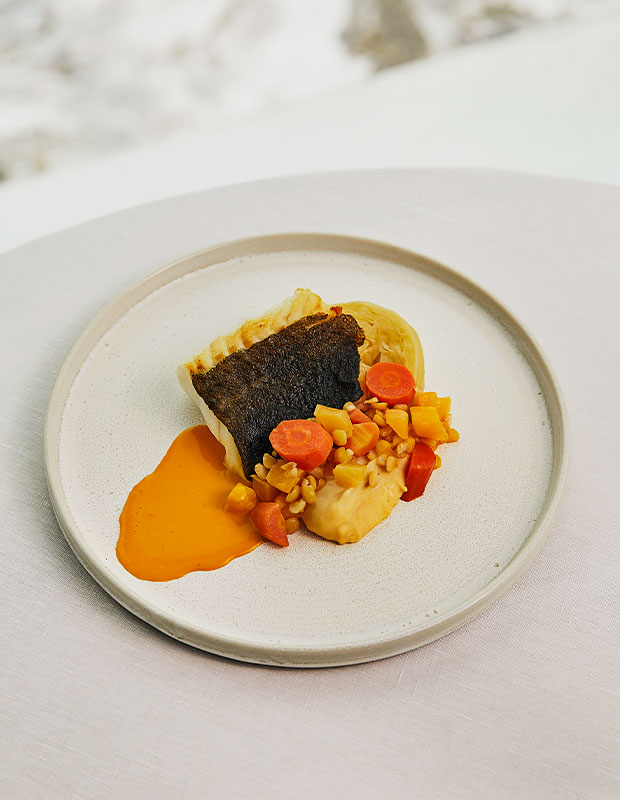Recipe
December 2, 2022
Fogo Island Cod with Cellared Vegetables and Peas Pudding

 “Back in the day, out on the North Atlantic, in order to put food on the table you had to fish and salt your catch to preserve it; you had to grow your own vegetables and can or cellar them; and you had to pray that the merchant vessels showed up before the winter ice set in. Newfoundland and Labrador’s culinary culture was based on the burden of survival: Good thing it’s also so delicious. At the Fogo Island Inn, chef Timothy Charles uses the same ingredients but tweaks the local classics by incorporating techniques like fermenting and searing instead of salting and boiling. This makes for dishes that are as beautiful as the island and all of its wonderful traditions.” – Timothy Charles
“Back in the day, out on the North Atlantic, in order to put food on the table you had to fish and salt your catch to preserve it; you had to grow your own vegetables and can or cellar them; and you had to pray that the merchant vessels showed up before the winter ice set in. Newfoundland and Labrador’s culinary culture was based on the burden of survival: Good thing it’s also so delicious. At the Fogo Island Inn, chef Timothy Charles uses the same ingredients but tweaks the local classics by incorporating techniques like fermenting and searing instead of salting and boiling. This makes for dishes that are as beautiful as the island and all of its wonderful traditions.” – Timothy Charles
Directions
Yield: Serves 6
- To make the fermented carrot juice, stir 5 grams of salt into each 1 cup of carrot juice. Let the juice sit in a glass jar in warm place for a minimum of 3 days; when small bubbles begin to form and the juice takes on a pleasantly sour taste, it’s ready to use. The sauce can be made without fermenting the carrot juice, but it will require generous seasoning, with approximately 2 teaspoons salt.
- For the carrot sauce, warm the fermented carrot juice in a medium pot over low heat. Whisking quickly, add cold cubes of butter one at a time until completely emulsified. Add salt to taste. Set aside.
- To make the cellared vegetables, blanch the carrots in salted boiling water until just tender, 5 to 8 minutes, depending on the thickness of your carrots. Remove from the water, then repeat the same steps for the rutabaga. Remove from water and set aside, but don’t throw out the cooking water as it will be used later in the cooking process.
- Preheat the oven to 350F.
- In an ovenproof skillet over medium-low heat, gently cook the cabbage with . cup of butter, making sure to keep the wedges intact. After flipping the wedges once, season generously with apple cider vinegar, brown sugar and salt. Add about . cup of the carrot and rutabaga cooking water or enough to cover the bottom of the skillet in liquid. Cover with parchment paper, tucking it into the sides of the pan, and place in preheated oven for about 10 minutes, or until the cabbage is fork tender. Remove from oven and set aside.
- For the peas pudding, use the rest of the vegetable cooking water to boil the split peas until tender, but not falling apart, about 30 minutes. Remove 1/2 cup of peas for later, then continue boiling the rest of the peas until they start falling apart. The peas should always be covered in liquid so you may need to add more until they are done cooking, about 40 minutes total. Strain off the cooking liquid and reserve. In a blender, add the peas and . cup butter, blending until the puree is rich and shiny. Season to taste and set aside.
- To sear the cod, pat the skin dry with paper towel. Add the canola oil to a large non-stick skillet over medium-high heat, then sear the fish skin-side down, pressing gently on the flesh so all the skin comes in contact with oil. After searing on the stove for 1 minute, place the fish in oven for 4 more minutes or until almost cooked through. Remove from oven, flip the fish over in the pan and allow for carryover cooking in the pan off the heat. Season to taste.
- In a medium pot, finish the vegetables by warming 1/4 cup of butter with some of the split pea and vegetable stock. Gently heat the cooked carrots, rutabaga and reserved whole split peas. Warm the cabbage wedges in . cup butter, making sure to keep them intact. Heat the split peas pudding in a small pot as well, adding stock if it becomes too firm and dry.
- To serve, pool some of the carrot sauce on each plate next to a nice dollop of peas pudding, a pile of the vegetables and a wedge of cabbage. Top each serving with a piece of seared cod.
Spafaxina
Recipe excerpted from Canada's Best New Cookbook edited by Amy Rosen, published by Indigo Press.


